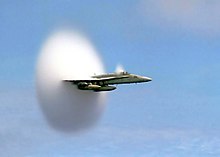
Back Klankgrens Afrikaans جدار الصوت Arabic Barrera del soníu AST Гукавы бар’ер Byelorussian Barrera del so Catalan دیواری دەنگ CKB Lydmur Danish Überschallflug#Schallmauer German Sonmuro Esperanto Barrera del sonido Spanish


- Subsonic
- Mach 1
- Supersonic
- Shock wave
The sound barrier or sonic barrier is the large increase in aerodynamic drag and other undesirable effects experienced by an aircraft or other object when it approaches the speed of sound. When aircraft first approached the speed of sound, these effects were seen as constituting a barrier, making faster speeds very difficult or impossible.[3][4] The term sound barrier is still sometimes used today to refer to aircraft approaching supersonic flight in this high drag regime. Flying faster than sound produces a sonic boom.
In dry air at 20 °C (68 °F), the speed of sound is 343 metres per second (about 767 mph, 1234 km/h or 1,125 ft/s). The term came into use during World War II when pilots of high-speed fighter aircraft experienced the effects of compressibility, a number of adverse aerodynamic effects that deterred further acceleration, seemingly impeding flight at speeds close to the speed of sound. These difficulties represented a barrier to flying at faster speeds. In 1947, American test pilot Chuck Yeager demonstrated that safe flight at the speed of sound was achievable in purpose-designed aircraft, thereby breaking the barrier. By the 1950s, new designs of fighter aircraft routinely reached the speed of sound, and faster.[N 1]
- ^ Nemiroff, R.; Bonnell, J., eds. (19 August 2007). "A Sonic Boom". Astronomy Picture of the Day. NASA. Retrieved August 30, 2010.
- ^ "F-14 Condensation cloud in action". web.archive.org. Retrieved: August 30, 2010.
- ^ sonic barrier Archived 2016-10-13 at the Wayback Machine. thefreedictionary.com.
- ^ sound barrier Archived 2015-04-11 at the Wayback Machine. oxforddictionaries.com.
Cite error: There are <ref group=N> tags on this page, but the references will not show without a {{reflist|group=N}} template (see the help page).